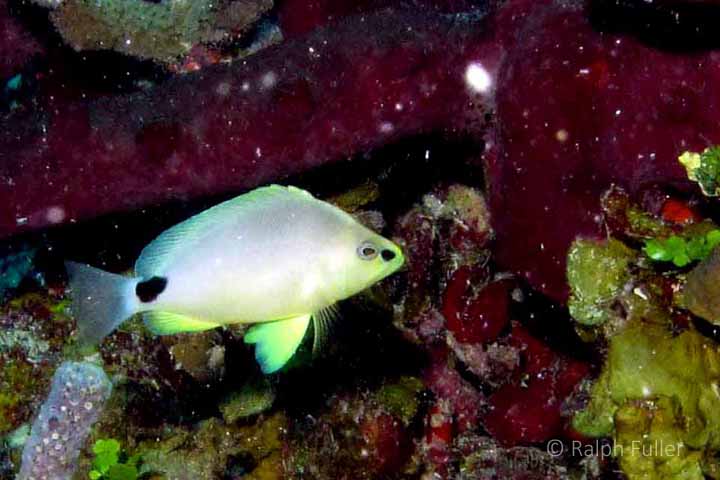
WHO KNEW THAT SPOTTING LITTLE GUYS LIKE BUTTER AND BARRED HAMLET FISHES could be challenging? I’ve thought of them as fairly bland little fishes of modest interest. I’m aware of occasionally seeing vivid blue indigo hamlets (Hypoplectus indigo) in Bonaire and Belize but not the other dozen or so species to be found around the tropical Atlantic/Caribbean.
Which sounds fishy considering that Humann and DeLoache’s Reef Fish Identification says barred hamlets (Hypoplectus puella) constitute the most common hamlet fishes in the Caribbean.
I surmise that, because barred hamlets are more muted in their coloration, almost mundane, I overlooked them. On the other hand, on my subsequent trip to Bonaire in January, I kept my eyes open for them and, again, only found a few indigos.

FINDING FIVE HAMLET SPECIES
On a trip to Turneffe Atoll off Belize, Turneffe Flats divemaster Denroy Usher introduced me to the Hamlet Grand Slam – the quest to spot five different hamlet species, all small, unobtrusive members of the sea bass family. Denroy means on the same dive. I was lucky to find them on the same week-long trip.
They’re a little complicated. Fishbase.org identifies 17 species, other sources 10 or 11. In Reef Fish Behavior, Ned Deloach calls them enigmatic, since anatomically all the species are basically identical with only coloration distinguishing them. And there’s a tendency for species to cross mate, creating some not uncommon hybrids in terms of coloration.

As noted, although hamlet fishes are five or six inches long at maximum, and often smaller, they are members of the Family Serranidae, which encompasses large groupers like Nassau and tiger groupers – and megagroupers – just smaller. Hamlets occupy Genus Hypoplectrus, are carnivorous like their larger cousins and have similar anatomy and swimming techniques.

NEW GUYS IN TOWN
In evolutionary terms, they’re apparently new to the neighborhood – and the neighborhood is only to the east of Central America. That is, they appear to have evolved in the Atlantic/Caribbean basin after the Isthmus of Panama rose up to connect North and South America and separate it from the Pacific basin several million years ago (see “The Far Side of the World and the Triangle of Diversity”).
Barred, butter and black hamlets are considered to be distributed over a wide region, but none are universally distributed. And blue hamlets are found only in the Florida Keys, golden and masked hamlets primarily in the southern Caribbean.
This is often attributed to geographic isolation due to various ice ages that lowered sea level. But a team of scientists in Great Britain and Canada have suggested speciation has been influenced more by ecological factors, such as competition for food and habitat, than geographic issues. They note that even widespread hamlet species are not found everywhere.
Additionally, they note that many scientists suggest the possibility that hamlets are still evolving, working toward a new species.

FEEDING AND REPRODUCTION
Hamlet fishes tend to be solitary hunters that occupy limited territories, keeping near the bottom and feeding primarily on small crabs, fishes and shrimps.
They are simultaneous hermaphrodites – they alternate the male and female roles of releasing eggs and milt. They spawn at dusk, moving to spawning sites to meet up with mates. Courtship dances can take as long as an hour. Actual spawning by folding (clasping, click here for photo) their bodies together to release eggs and milt is done in three seconds. The process is repeated a number of times, with the fishes alternating the male and female roles.
PRINCIPAL SOURCES: Reef Fish Behavior, Ned DeLoach; Reef Fish Identification Florida, Caribbean, Bahamas, Paul Humann, Ned DeLoach; www.reefbase.org; “Hamlet fish shed light on evolution,” B.G. Holt, I. M. Cote and B.C. Emerson, University of East Anglia/Simon Fraser University.
